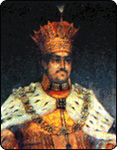Awadh Rulers
Ghazi-ud-din Haider (1814-1819)
 Ghazi-ud-din Haider ascended the throne in 1814. He got built two houses within the Motimahal complex, the Mubarak Manzil and Shah Manzil. He also introduced for the first time animal fighting sport, which was hitherto unheard in Lucknow. Ghazi-ud- din used to watch these fights from Shahmanzil, which took place on the other side of the river at Hazari Bagh.
Ghazi-ud-din Haider ascended the throne in 1814. He got built two houses within the Motimahal complex, the Mubarak Manzil and Shah Manzil. He also introduced for the first time animal fighting sport, which was hitherto unheard in Lucknow. Ghazi-ud- din used to watch these fights from Shahmanzil, which took place on the other side of the river at Hazari Bagh.
He got a European style house built for one of his European wife and named it 'Vilayati Bagh. ' The edifice of Qadam Rasul was constructed near it. According to popular belief this impression of the supposed footprints of Muhammad on black stone, was brought from mecca, by some distinguished pilgrim. Though badly damaged in 1857, the stone bearing the footprint still stands, on a high pedestal near Sikandar Bagh (NBRI).
Ghazi-ud-din Haider due to his religious fervor; reproduced on the banks of Gomti near Sikander bagh, a sacred Najaf, a holy mausoleum, the copy of Ali's burial place at Najaf in Iraq. He was buried here at his death in 1827. Later his three begums were also buried at Shah Najaf Imambara -Sarfaraz Mahal, Mubarak Mahal and Mumtaz Mahal. In his life time itself; Ghazi-ud-din Haider had constituted the unique 'Vasiqa system' an endowment arrangement with the British, for the upkeep of lmambaras. With the interest of the 'perpetual loans', the maintenance of the lmambaras was to be taken care of. In 1886 the vasiqa legislation was passed with which the arrangments were regularized and a board of trustees, which continues to this day was instituted, to manage the funds. The vasiqas continue to the present time and the Bara Imambara, Chotta Imambara and the Shahnajaf Imambara are looked after by them
Comments

